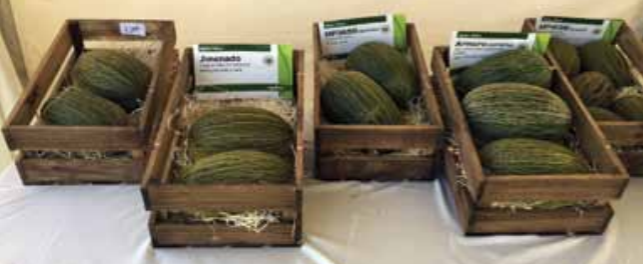Syngenta Seed the top of the range selection in melons
The seed company presented its novelties for the European, African and Middle Eastern markets during a three-day technical session at Torre Pacheco.
The 300 people attending the technical session at Torre Pacheco, the melon capital, who had come mainly from Europe but also from Central America, Mexico, Israel, Algeria and Egypt, showed definite interest in the 120 varieties being presented (80 melons and 40 watermelons). The Syngenta team was there to listen to them.
“We have had a lot of requests for melons with very different eating profiles, colours, shapes and tastes,” said the breeder Matthew Kinkade, Breeding Project Lead – Watermelon, who had come from the California office.
The information Syngenta collects allows it to redirect its research according to all their needs and to offer varieties to suit each geographical area and type of market. For this reason, the group has a network of experimenters who conduct trials throughout the world.
Innovation along two lines
There are two main reasons for creating new varieties. “For a start, each year we improve pest and disease resistance, yields and post-harvest conservation, depending on local needs,” explained Philippe Chatin, the Marketing Manager for Europe, Africa and the Middle East. As well as this purely agricultural aspect there is innovation as such, which takes market developments, influenced by consumers and distributors, into account. This involves differentiation in terms of skin colour, flesh colour, shape and, most particularly, eating quality.
Fresh-cut watermelon leader
In the watermelon category, particularly for seedless types, research is focusing on adjusting the sizes to obtain smaller fruit and on a definite improvement in eating quality. Kasmira and Red Jasper are among Syngenta’s flagship varieties, as they have set a new benchmark for eating quality. Prestige, a small -sized fruit, is a major innovation in its segment because it keeps very well and tastes superb.
The multinational has also recently launched Crisp Delight, which is used for fresh-cut fruit and has made the group a leader in the segment, which is growing by 7% a year.
“We have a unique research programme that aims to satisfy the entire value chain with a product that leaves little waste at the factory and sheds little liquid into the pack, while remaining juicy and well -coloured for consumers,” said Jérémie Chabanis, the Value Chain Strategic Partnership Lead.
The red-fleshed variety is already on the market and a yellow-fleshed variety is under development to provide an alternative to pineapple or mango in fruit salads.
Repositioning Piel de Sapo melons
While the watermelon market is on top form, the melon market has seen a 30% drop in production over the past five years. To halt this trend, the sector needs to get moving. Syngenta is working on new sizes, flesh colours, skin colours and premium varieties, and even on different flavours, such as Gwanipa, a slightly tangy melon that the company launched a few years ago. Prominent among the 80 new varieties are Valerio, an Italian-American melon for open field crops; Gharam and Marques, two Galia-type varieties for which Syngenta has preferred to opt for a short-distance (domestic market) shelf life rather than lengthy conservation in order to prioritise the traditional Galia melon taste; Arpon and Tazha, two Charentais types that currently offer the best resistance to water soaking; and the Piel de Sapo types Armero, Velasco, Jimenado and Dominio, which have allowed Syngenta to return to the market as a specialist in this segment.
As regards future innovations,
“they are still directed towards improving the flesh, between very juicy, firmer or less firm, and above all towards making the flavour more consistent over all the varieties throughout the season,” Jérémie Chabanis added.
Consistent eating quality is the seed companies’ big challenge, to keep up the level of consumer satisfaction. A consumer who has been disappointed by a melon will turn away from this fruit and will take between 5 and 10 weeks to buy another.
Real synergies throughout the sector
The social environment is evolving fast and types of consumption are changing. Syngenta is highly committed to this, with the backing of sector buyers who are also familiar with the consumers. Syngenta presents varieties to the specialists during technical days, organises product tastings and in-store trials to test consumer reactions, and supports retailers with marketing and merchandising approaches to launch the products. All these actions generate real synergies to improve the entire sector and satisfy consumers.



